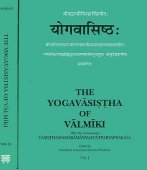Yan, Yaṅ, Yañ, Yaṇ, Yāṇ, Yāṉ: 5 definitions
Introduction:
Yan means something in Hinduism, Sanskrit, Tamil. If you want to know the exact meaning, history, etymology or English translation of this term then check out the descriptions on this page. Add your comment or reference to a book if you want to contribute to this summary article.
In Hinduism
Vyakarana (Sanskrit grammar)
Source: Wikisource: A dictionary of Sanskrit grammarYaṅ (यङ्).—See य (ya) (l2) and (13) above.
--- OR ---
Yañ (यञ्).—(l) short term (प्रत्याहार (pratyāhāra)) formed by the letter य (ya) of हयवरट् (hayavaraṭ) and the mute letter ञ् (ñ) of इभञ् (ibhañ) including serni-vowels and the third and the fourth consonants excepting घ्, ढ् (gh, ḍh) and ध् (dh) of the five consonant groups: cf. अतो दीर्घो यञि (ato dīrgho yañi) P. VII. 3. 10l ; (2) tad. affix added (a) in the sense of गोत्र (gotra) (grand-children and their descendants) to words of the गर्ग (garga) class and some other words under specific conditions, e.g. गार्ग्यः वात्स्यः, काप्यः (gārgyaḥ vātsyaḥ, kāpyaḥ) etc., cf. गर्गादिभ्यो यञ् (gargādibhyo yañ) and the following P.IV. 1. 105-108: (b) in the sense of collection to केदार, गणिका, केश (kedāra, gaṇikā, keśa) and अश्व (aśva), cf. P.IV.2.40 and the Varttika.thereon and IV. 2.48; (c) in the Saisika senses to the word द्वीप (dvīpa), cf. P.IV.3.10: (d) to the word कंसीय (kaṃsīya) e. g. कांस्यम् (kāṃsyam) cf. P.IV.3.168, and (e) to the words अभिजित्, विदभृत् (abhijit, vidabhṛt) and others when they have the tad. affix अण् (aṇ) added to them : e.g. आभजित्यः (ābhajityaḥ) cf. P. V. 3. 118.
--- OR ---
Yaṇ (यण्).—A brief term for letters य्, व्, र् (y, v, r) and ल् (l) , i.e. the semi-vowels;cf. इको यणदि (iko yaṇadi) P. VI. I. 77; cf. also I. 1.45 and VI. 4. 81.

Vyakarana (व्याकरण, vyākaraṇa) refers to Sanskrit grammar and represents one of the six additional sciences (vedanga) to be studied along with the Vedas. Vyakarana concerns itself with the rules of Sanskrit grammar and linguistic analysis in order to establish the correct context of words and sentences.
Languages of India and abroad
Sanskrit dictionary
Source: DDSA: The practical Sanskrit-English dictionaryYaṅ (यङ्).—A term for the sign of the Frequentative.
Source: Cologne Digital Sanskrit Dictionaries: Monier-Williams Sanskrit-English Dictionary1) Yaṅ (यङ्):—(in gram.) a term for the Intensive suffix ya, [Pāṇini 3-1, 22 etc.]
2) Yaṇ (यण्):—(in gram.) a term for the semivowels y, r, l, v, [Pāṇini]
3) Yan (यन्):—[from yad] in [compound] for yad.
[Sanskrit to German]
Sanskrit, also spelled संस्कृतम् (saṃskṛtam), is an ancient language of India commonly seen as the grandmother of the Indo-European language family (even English!). Closely allied with Prakrit and Pali, Sanskrit is more exhaustive in both grammar and terms and has the most extensive collection of literature in the world, greatly surpassing its sister-languages Greek and Latin.
See also (Relevant definitions)
Starts with (+441): Yamadhye, Yamamhishthiya, Yamatra, Yamaya, Yamdu, Yamkara, Yamtara, Yamtracalaka, Yamtracalita, Yamtragara, Yamtrakale, Yamtrakarmi, Yamtranagarikate, Yamtrapide, Yamtraprayoga, Yamtrashastra, Yamtrashilpa, Yamtrashilpajna, Yamtrashilpajne, Yamtrashilpi.
Ends with (+1035): A-mid o-raw a-tyan, Aakhyan, Abhivyan, Abhiyan, Acakkiyan, Acankaiyan, Accatiyan, Aciriyan, Adakkamaniyan, Adapathiyan, Adhyayan, Agamayan, Agamudaiyan, Agaran moyan, Agyan, Ailiyan, Airyaporiyan, Ajavayan, Akalyan, Akamutaiyan.
Full-text (+449): Yanluganta, Yanluk, Ganikya, Yanadeshasutra, Yanlugantashiromani, Yananta, Yanaman, Yanimittam, Shen lu shan long yan, Yad, Yannimitta, Yamadhye, Sadharanya, Jyaishthya, Yamurdhan, Yamamhishthiya, Yamula, Haumya, Janjana, Sauhridya.
Relevant text
Search found 78 books and stories containing Yan, Yaṅ, Yañ, Yaṇ, Yāṇ, Yāṉ; (plurals include: Yans, Yaṅs, Yañs, Yaṇs, Yāṇs, Yāṉs). You can also click to the full overview containing English textual excerpts. Below are direct links for the most relevant articles:
The Agni Purana (by N. Gangadharan)
Chapter 349 - The pratyāhāras and fundamental rules in Grammar (vyākaraṇa)
Chapter 259 - The application of the mantras of the Ṛgveda (ṛgvidhāna)
Vakyapadiya of Bhartrihari (by K. A. Subramania Iyer)
Verse 1.59 < [Book 1 - Brahma-kāṇḍa (or Āgama-samuccaya)]
Verse 3.14.122 < [Book 3 - Pada-kāṇḍa (14): Vṛtti-samuddeśa (On Ccomplex Formation)]
Verse 3.14.123 < [Book 3 - Pada-kāṇḍa (14): Vṛtti-samuddeśa (On Ccomplex Formation)]
Vasudevavijaya of Vasudeva (Study) (by Sajitha. A)
Taddhita (in Sanskrit grammar) < [Chapter 3 - Vāsudevavijaya—A Grammatical Study]
Sandhi (a): Svarasandhi < [Chapter 3 - Vāsudevavijaya—A Grammatical Study]
Sanskrit Grammarians (5): Kṣīrasvāmin < [Chapter 5 - Impact of other Disciplines in Vāsudevavijaya]
Manusmriti with the Commentary of Medhatithi (by Ganganatha Jha)
Verse 8.173 < [Section XXX - The Royal dues and the King’s duty regarding them]
Verse 5.129 < [Section XIII - Purification of Substances]
Verse 9.20 < [Section I - Husband and Wife]
Tiruvaymoli (Thiruvaimozhi): English translation (by S. Satyamurthi Ayyangar)
Pasuram 6.8.5 < [Section 8 - Eighth Tiruvaymoli (Pon-ulaku aliro)]
Pasuram 2.9.2 < [Section 9 - Ninth Tiruvaymoli (Em ma vittu)]
Pasuram 4.3.10 < [Section 3 - Third Tiruvaymoli (Kovai Vayal)]
Dhammapada (Illustrated) (by Ven. Weagoda Sarada Maha Thero)
Verse 308 - The Monks Who Lived on the Bank of the Vaggumudā River < [Chapter 22 - Niraya Vagga (Hell)]
Verse 227-230 - The Story of Atula the Lay Disciple < [Chapter 17 - Kodha Vagga (Anger)]
Related products
